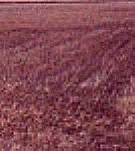

| We often take soil for granted. However, soil is one of the most important resources in sustaining life. Productive soil usually combines both organic and inorganic components. Organic material is formed when dead plant or animal material is broken down into "humus". The inorganic parts of soil are mostly formed when rocks are broken down by the action of water and wind. Soil also contains living material such as fungi and worms. |
The glaciers played a large role in redistributing soil in the northern hemisphere. This, in turn, affected the distribution of various types of vegetation.
Vegetation and availability of water can affect the type of soil found in an area. For instance, desert areas typically have poor soils because of the low amount of precipitation. The composition of the soil can affect how well it drains which affects the type of vegetation which an area can support; this can then affect how the soil develops.
Clay soils are often found in areas which were formerly sea or lake bottoms. Bogs, which usually have poor soils, often form over clay deposits because of the poor drainage.
Soils develop and mature over time. The term "horizon" refers to the typical layered structure of soils. For example, the top layer usually consists of coarse organic material. Lower layers may contain a combination of "converted" organic material and rock particles.
![[home]](gsbann.gif)